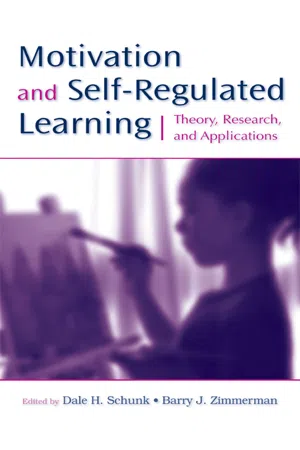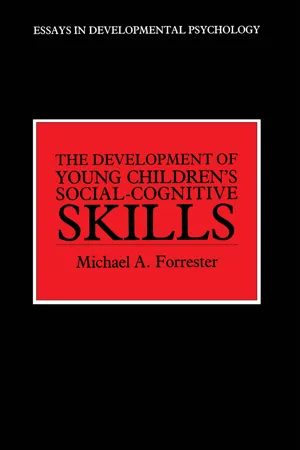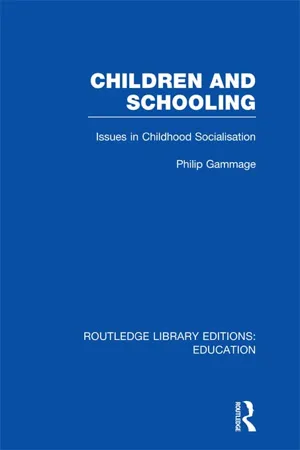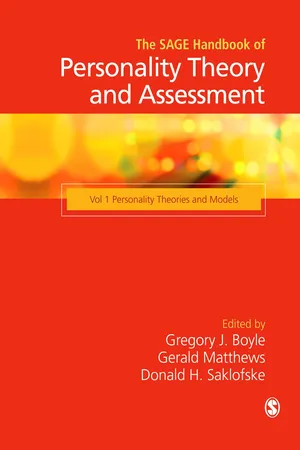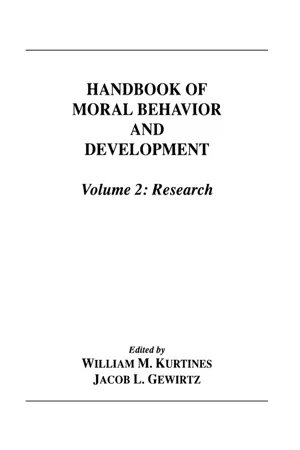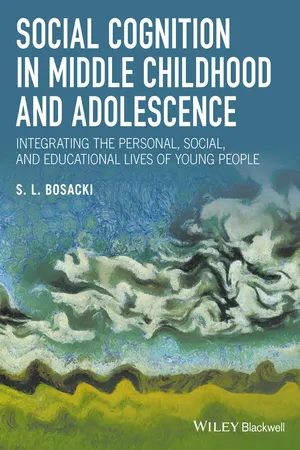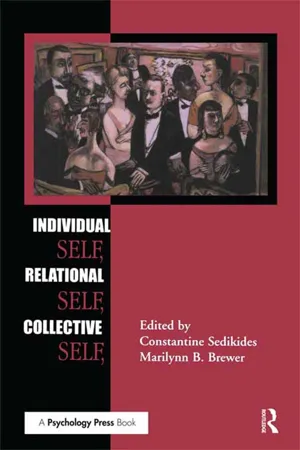Psychology
Social Cognitive Theory of Personality
The Social Cognitive Theory of Personality, proposed by Albert Bandura, emphasizes the role of cognitive processes, social interactions, and environmental influences in shaping an individual's personality. It highlights the importance of observational learning, self-efficacy, and the reciprocal interaction between personal factors, behavior, and the environment in understanding and predicting personality development and functioning.
Written by Perlego with AI-assistance
Related key terms
Related key terms
1 of 4
Related key terms
1 of 3
11 Key excerpts on "Social Cognitive Theory of Personality"
- eBook - ePub
Motivation and Self-Regulated Learning
Theory, Research, and Applications
- Dale H. Schunk, Barry J. Zimmerman, Dale H. Schunk, Barry J. Zimmerman(Authors)
- 2012(Publication Date)
- Routledge(Publisher)
reciprocal determinism, the view that (a) personal factors in the form of cognition, affect, and biological events, (b) behavior, and (c) environmental influences create interactions that result in a triadic reciprocality. From this perspective, people are viewed as self-organizing, proactive, self-reflecting, and self-regulating rather than as reactive organisms shaped by environmental forces or driven by concealed inner impulses. They are both products and producers of their own environments and of their social systems. For example, how people interpret the results of their own behavior informs and alters their environments and their personal factors, which in turn inform and alter subsequent behavior. Bandura altered the label of his theory from social learning to social “cognitive” both to distance it from prevalent social learning theories of the day and to emphasize that human cognition plays a critical role in people’s capability to interpret reality, self-regulate, encode information, and perform behaviors.Social cognitive theory provides multiple lenses through which to view the manner in which appropriate actions can be undertaken to improve human functioning. In school, for example, teachers can foster the competence of the students in their care by improving their students’ emotional states, faulty self-beliefs, or habits of thinking (personal factors) by enhancing their academic skills and self-regulatory practices (behavior) and by altering the social, school, and classroom structures that may work to undermine student success (the environment). Indeed, because of the reciprocal nature of the causes of human functioning, it can be expected that results obtained in one sphere will lead to subsequent changes in another.Rooted within Bandura’s (1986) conception of reciprocal determinism is the understanding that individuals are imbued with the personal factors that define what it is to be human. Primary among these are the capabilities to symbolize, plan alternative strategies (forethought), learn through vicarious experience, self-regulate, and self-reflect. These capabilities provide humans with the cognitive means by which they are influential in determining their own destiny. This is a view of human agency in which individuals are proactively engaged in their own development and can make things happen by their actions. Key to this sense of agency is the fact that individuals possess the self-beliefs that enable them to exercise a measure of control over their thoughts, feelings, and actions, that “what people think, believe, and feel affects how they behave” (Bandura, 1986, p. 25). For this reason, the beliefs that people have about themselves and about their capabilities are critical elements in the exercise of control and personal agency. In 1997, Bandura published Self-Efficacy: The Exercise of Control - Michael A. Forrester(Author)
- 2013(Publication Date)
- Psychology Press(Publisher)
Chapter Three Interactionist Social-cognitive DevelopmentThe preceding comments have, I hope, succeeded in identifying reasons why we might wish to be more circumspect regarding the potential of individualistic (constructivist/representational) approaches as guiding theories for our investigations of children's developing social-cognitive skills. This is only the first part of the story, however. As discussed in Chapter 1 , within psychology there has long existed a tradition of considering some topics as intrinsically individualistic (memory)1 while others as essentially social (altruism, attitude formation and so on). In this chapter I wish to consider developmental social cognition research which maintains or is at least emergent from social interaction constructs. As before the aim is to strike a balance between reviewing the major studies, identifying the underlying theories and approaches, and evaluating what has emerged with reference to understanding children's participative social-cognitive skills.Over the last 15-20 years there has been a growth in developmental social cognition research which adopts or emphasises the importance of the child's social interactions. There are three principle themes in this research; the Genevan school which Durkin (1986) has coined social social cognition (in contrast to cognitive social cognition—the themes outlined in the previous chapter); work inspired by Vygotskian perspectives on development; and one or two studies which can be traced to Mead and the symbolic interactionist school. These different research traditions have been brought together precisely because each in their own way emphasises the importance of the social world (and social interaction processes) for the child's developing social cognitions.The Genevan School
This social interactionist perspective (Doise & Mugny, 1984) argues that social interaction itself establishes the fabric within which children's social understanding develops. Thus the confrontational aspects endemic to everyday social interaction (i.e. differing perspectives coming together through social interaction) gives rise to the formation of new social-cognitive structures within the individual. It is argued that via the facilitative and constraining aspects of social interaction contexts, social cognition is achieved. However, although there is a wealth of data with regard to effects arising from interpersonal relations and group processes (particularly in social psychology, e.g. Brown, 1988), there is considerably less detail on process. Furthermore, although the focus in now upon the social interaction context, explanations for the mechanisms of socio-cognitive change remain largely neo-Piagetian, that is, an emphasis on conflict and confrontation as the 'triggering' process, whereby one stage of socio-cognitive development might evolve to the qualitatively distinct next stage.- eBook - ePub
- Joseph M. Wepman(Author)
- 2017(Publication Date)
- Routledge(Publisher)
IIISocial Process and PersonalityPassage contains an image
12The Cultural Context of Personality Theory
Norman M. BradbumIt is a fundamental fact of human life that man is a social animal. The long developmental period and absence of a large set of instinctive response patterns insure that every child will spend most of its waking life in the presence of other people who, individually and collectively, exert “socialization” pressures. For most people the greater part of their adult life is spent with other people who have grown up under basically similar socialization pressures, who share the same language, who have many of the same basic ideas about the ways in which the world should be organized and who desire the same goals in life. Although each individual is unique, he also shares many attributes with others who live in his culture. It is important for the student of personality to consider the cultural context within which human personality develops and functions, lest he confuse factors specific to a particular culture with those that are more general in their influence on personality development and functioning.Sociological and anthropological literature distinguishes between two sets of variables, culture and society. The term “culture” is usually taken to include such things as values (“conceptions of the desirable”), beliefs and knowledge about the world, laws, customs, arts and language. The term “society” refers to a set of relationships or “institutions” such as economic, political and religious organization, grouping and rankings of individuals as in social classes, and types of family and domestic arrangements. These two sets of variables constitute on the one hand a system of shared cognitions about the environment and the proper ways’ of behaving and, on the other, a set of rules or norms governing the ways in which economic, political, religious and domestic activities should be organized. The socialization process, if it is successful, insures that the maturing child will accept and internalize the system of beliefs and norms governing relationships among people. These beliefs and norms in turn become the basic frame of reference within which the adult experiences his world. - eBook - ePub
Media Effects
Advances in Theory and Research
- Mary Beth Oliver, Arthur A. Raney, Jennings Bryant, Mary Beth Oliver, Arthur A. Raney, Jennings Bryant(Authors)
- 2019(Publication Date)
- Routledge(Publisher)
In this environment, general social learning theories initially emerged (Bandura & Walters, 1963). These theories focused on imitation and rewarded behaviors. Where behaviorism placed emphasis squarely on internal mental processes (i.e., paired associations), social learning theories moved the focus to environmental cues (Bandura, 1986). However, these general theories of social learning failed to explain why individuals imitated the behaviors of others when the imitator was not directly rewarded for the behavior or why novel behaviors were ever undertaken in the first place. As a result, Bandura (1986) began to focus on environmental cues and cognitive processes that guide us. In retrospect, Bandura’s suggestion that environmental cues provide information for potential imitation, but that imitation also requires self-efficacy and motivation, seems obvious. At the time, though, it required a shift in thinking—in some cases, a dramatic one—to arrive at this current moment of understanding.Whereas a bulk of the related research, especially in the area of media effects, has focused on behavioral outcomes of learning (i.e., modeling, imitation), cognition was from the beginning crucial to the theory (Bandura & Walters, 1963). This fact became more clear in 1986 when Bandura introduced the full scope (and changed the name) of the theory, introducing concepts of self-regulation and self-reflection as important to the processes of learning. It was then that the importance of environment—more specifically, our cognitive situation and human agency in the environment—was identified as the factor that ultimately encourages or dampens learning likelihood.Explicating the Theory
Social cognitive theory (SCT), in simplest terms, explains how humans can learn and be motivated to perform behaviors by observing others. But this does not mean that humans simply mimic others. SCT is based on an agentic perspective (Bandura, 1986, 2006), meaning that the theory views humans as having agency: We are proactive, self-regulating, self-organizing, and both purposefully and reflexively adaptive to changes in the environment. This understanding of agency is crucial. As will be discussed below, although our environment provides much needed input to aid in learning and behavioral processes, SCT emphasizes the vital aspect that information processing and human motivation play; that is, whereas factors external to us may influence our actions, the origins of our actions are internal. Humans are not mere imitators; we are not automatons. - eBook - ePub
- Phillip Gammage(Author)
- 2012(Publication Date)
- Routledge(Publisher)
Chapter 7Self-Esteem and Social Learning
PERSONALITY AND SELF-ESTEEM: AN INTRODUCTIONStudies of personality are really studies about individual differences: the very core of psychology. (Each of us has a limited appreciation of our own personality.) Others may talk of it as attractive, complex, painfully shy, morose, and so on. We may view ourselves generously or critically. Rarely can we assess our own personalities, and never do we really see ourselves as others see us. So what is personality? It is, quite simply, the actual quality of being recognisably human and unique. Dictionary definitions usually stress that the term is used as signifying the totality of a person's behaviour and emotions, or the unique organisation of the person's traits, dispositions, habits and feelings.Whereas the ‘self may be thought of as the recognition of one's own personality, it is in reality an abstraction that each person develops about himself for herself. The ‘self is the perception one has of one's attributes, qualities (both intellectual and emotional), about one's behaviour and one's physique. This abstraction is represented by the term ‘me’. ‘I’ recognises ‘me’ as unique. The concept ‘me’ is learned in the course of development from a neo-nate to an adult. It is learned in the course of events which enable one to locate, measure and compare oneself with others, and it is self-referent, that is, it cannot be viewed as objectively as ‘you’ the total personality might be by others. Thus, the self and personality are not quite the same thing. Others may appraise your personality, weigh and compare its various facets with a colder or a warmer eye than you. The self is an abstraction that is selective. Certain aspects will be valued in our own appraising more than others. Certain people close to us as we grow (notably our parents and peers) will be more salient to and more formative of our emotions, desires and intellect than others. The gradual growth of the personality and of the ‘self will be subject to strange choices, odd elements of selectivity. - eBook - ePub
The SAGE Handbook of Personality Theory and Assessment
Personality Theories and Models (Volume 1)
- Gregory J Boyle, Gerald Matthews, Donald H Saklofske, Gregory J Boyle, Gerald Matthews, Donald H Saklofske(Authors)
- 2008(Publication Date)
- SAGE Publications Ltd(Publisher)
Assess persons-in-context. The fifth guideline calls attention to the contexts in which people live their lives. Social-cognitive theory indicates that a complete assessment of personality structure and dynamics must consider the contexts of persons lives (e.g. Zakriski et al., 2005). Contextualized assessment is required if one is assessing overt dispositional tendencies, since individual’s distinctive tendencies include contextualized patterns of variability in response (Andersen and Chen, 2002; Ayduk et al., 2000). Attention to context is also required when assessing internal personality systems, since both cognitive personality structures (Cantor and Kihlstrom, 1987) and biologically based systems of temperament (Kagan, 2003) inherently function contextually.THE KAPA (KNOWLEDGE-AND-APPRAISAL PERSONALITY ARCHITECTURE) MODEL AS AN EXPLANATORY MODEL OF PERSONALITY
Earlier, we noted that scientific explanation is grounded in explanatory models and that any such model is inevitably limited in some way; that is, any model is an imperfect representation of the world (Giere, 1999). An implication is that any model is, in principle, open to modifications or expansions. The social-cognitive frameworks of Bandura and of Mischel are generative conceptions upon which one can build. One goal in building is to formulate a principled set of social-cognitive structures and process variables. The author (Cervone, 2004) recently has proposed such a system. It draws upon, and is complementary to, the work of prior investigators in addition to Bandura and Mischel (e.g. Cantor and Kihlstrom, 1987; Ingram and Kendall, 1986; Kreitler and Kreitler, 1976; Lazarus, 1991; Matthews et al., 2000; Smith and Lazarus, 1990).A knowledge-and-appraisal personality architecture (KAPA)
The knowledge-and-appraisal personality architecture (KAPA) (Cervone, 2004) is designed to facilitate the goals discussed throughout this chapter. An overarching goal is to identify a system of cognitive and affective variables that are explanatory. The variables, then, should not be descriptors of overt dispositional tendencies but underlying psychological structures that contribute to the behavioral and emotional tendencies that one observes. The systems of variables should rest on a set of explicit principles that, in combination, yield a relatively comprehensive model of intra-individual personality architecture. One should be able to apply this model to the explanation of phenomena that are central to the psychology of personality, including cross-situational coherence in psychological response (Allport, 1937). - eBook - ePub
Handbook of Moral Behavior and Development
Volume 2: Research
- William M. Kurtines, Jacob Gewirtz, Jacob L. Lamb(Authors)
- 2014(Publication Date)
- Psychology Press(Publisher)
12 Social Contexts in Social Cognitive Development Elliot Turiel Judith G. Smetana Melanie Killen ABSTRACTThis chapter addresses the role of social context in social cognitive development. It is proposed that analyses of social contexts should include distinctions in social environmental components corresponding to differentiations in domains of social judgment. It is shown that global characterizations of the cultural ethos of this society yield conflicting portrayals. Whereas some assert that the central ethos of this culture is individualism, others claim that the culture is exemplified by a bureaucratic mentality of other-directedness. We propose that these opposing views reflect stereotypes that fail to capture the heterogeneous social orientations of persons in this culture. We further propose a “domain-specific” view of social contexts to avoid the stereotyping inherent in global characterizations of culture. Evidence for these propositions comes from several research traditions. We also discuss recent supporting research on social interactions in early childhood and on children’s judgments about moral issues and interpersonal relationships.Individualism is all the rage—in two respects. Many social scientists currently assert that our culture is individualistic at its core. And many social scientists rage at individualism because they view it as a major source of moral crisis in the society. It has become commonplace to portray this culture as characterized by an ethos of individualism and the psychology of persons in the culture as oriented to self-sufficiency, personal goals, autonomy, and detachment from others. Frequently invoked to illustrate the cultural ethos are the metaphors of the cowboy and the entrepreneur as lone, rugged, self-sustained individuals struggling for self-promotion against others or the society (cf. Kessen, 1979). The ethos of individualism is not solely presented as a social scientific description of the culture. Many who believe that the culture is highly individualistic also believe that individualism is largely responsible for what is perceived to be a state of moral decay in the society and collapse of social institutions (Bellah, Madsen, Sullivan, Swidler, & Tipton, 1985; Hogan, 1975; Sampson, 1977, 1978). - eBook - ePub
Theory and Cases in School-Based Consultation
A Resource for School Psychologists, School Counselors, Special Educators, and Other Mental Health Professionals
- Laura M. Crothers, Tammy L. Hughes, Jered B. Kolbert, Ara J. Schmitt(Authors)
- 2020(Publication Date)
- Routledge(Publisher)
reciprocal determinants of human behavior, since these factors act in concert and cannot be separated.Text Box 7.1 Albert BanduraAlbert Bandura has been ranked as the fourth most frequently cited psychologist of all time, behind only B. F. Skinner, Sigmund Freud, and Jean Piaget (Cherry, 2018).Thus, the social cognitive theory model (SCTC) of consultation arises from the theories of Bandura (1977a, 1977b, 1978), in which he proposed that the interplay of individuals’ behavior, individuals’ cognition, and the environment form the basis of human functioning. Moreover, the interrelationships among these factors influence both the consultee’s and the client’s functioning (Bandura, 1978). In this type of consultation, the motivation to combat the problem, as well as to establish self-efficacy and independence in the consultee, is highlighted (Bandura, 1977a, 1977b). Additionally, the goals of consultation are to alter or influence the relationships among person, environment, and interpersonal factors, while enabling the consultee to more effectively address the future problems that may arise in that client or others (Bandura, 1978).Brown and Schulte (1987) outline the assumptions and values of the SCTC of consultation. An overarching theme of SCTC is to promote positive changes within three variables: behavior, cognitions, and environment, rather than focusing on a single targeted area. Brown and Schulte (1987) assert that there are two philosophical assumptions that underpin the SCTC model: 1) Reciprocal determinism and, 2) Altering the homeostatic relationship between the behavior, cognitive, and environmental variables. The idea of reciprocal determinism in SCTC is that the relationship between behavior, cognitions, and the environment impact the three parties involved in the consultation process: the consultant, consultee, and the client. In order to fully understand the problems evidenced by the consultee and client, all three variables must be considered in the consultation process. - eBook - ePub
Social Cognition in Middle Childhood and Adolescence
Integrating the Personal, Social, and Educational Lives of Young People
- Sandra Bosacki(Author)
- 2016(Publication Date)
- Wiley-Blackwell(Publisher)
In addition to the aforementioned advanced social cognitive processes, social cognitive research also includes the role of self‐cognitions such as the development of self‐perceptions and understanding self‐concept development. In particular, a growing number of studies have started to explore how these self‐focused cognitive processes are relevant to social learning (Leeves & Banerjee, 2014; Wellman, 2014). Increasingly, research with children claims that the developmental processes involved in intra‐ and interpersonal understanding appear to be intricately interwoven (Bosacki, 2012; Hughes, 2011; Ruffman, 2014), and support the view that self and other perception derives from social experience (Mead, 1934).Similar to ToM research, since the field’s conception, the study of the self has included the challenge of internal theoretical conflict (Bridges, 1925; James, 1890; Mead, 1934). Such theoretical conflict has perhaps led to its continued popularity within various social science disciplines, especially in psychology (Rochat, 2009) and philosophy (Nagel, 1986; Wellman, 2014). Conceptually, the “theory” of the self shares the greatest affinity to ToM research given that it emphasizes the individual’s construction of the self, and deals with one’s feelings and beliefs directed toward oneself (Damon & Hart, 1988; Harter, 1999; Ruffman, 2014).In addition, since the 1960s, self‐concept research has moved from the monolithic conception of self (Rosenberg, 1965), to one that is multidimensional (Harter, 1999) and hierarchical in nature (Marshall et al., 2014). This notion of the dialogical or “omnibus” self suggests that the self is a dynamic, multilayered entity that reconceptualizes itself as a combination of cognitive abilities, and emotional and social experiences (Bruner, 1996; Orth & Robins, 2014).From a developmental perspective, a young person’s self‐concept becomes increasingly differentiated with age, and gradually shifts from the physical and active self in early childhood to the psychological and social self in early adolescence (Damon & Hart, 1988; Harter, 1999). During later childhood and early adolescence, the concept of the self moves from physical to mental terms as it increases in complexity and abstractness. Many researchers have noticed the similarities in children’s understanding of self and other, that person and self‐perceptions progress along a developmental continuum from concrete, physicalistic, and situation‐specific views of the self to abstract, psychological, and trait‐like self‐definition (Schaffer, 1996). - Constantine Sedikides, Marilynn B. Brewer, Constantine Sedikides, Marilynn B. Brewer(Authors)
- 2015(Publication Date)
- Psychology Press(Publisher)
Again like Baldwin and Cooley in particular, Mead (1934) argued for the relational nature of the self: “The individual possesses a self only in relation to the selves of the other members of his social group” (p. 164). The group was vital to the evolution of a self: “The process out of which the self arises is a social process which implies interaction of individuals in the group, implies the pre-existence of the group” (p. 164). Importantly, Mead emphasized “the temporal and logical pre-existence of the social process” to the self that arises from it (p. 186). Elaborating on this point, Mead highlighted the constant flux of the self: “The self is not something that exists first and then enters into relationship with others, but it is, so to speak, an eddy in the social current and so still a part of the current. It is a process in which the individual is continually adjusting himself in advance to the situation to which he belongs, and reacting back to it” (p. 182).Mead (1934) maintained that the social basis of the self does not preclude vast individual differences:The fact that all selves are constituted by or in terms of the social process, and are individual reflections of it—or rather of this organised behavior pattern which it exhibits …— is not in the least incompatible with … the fact that every individual self has its own peculiar individuality, its own unique pattern; because each individual self within that process, while it reflects in its organised structure the behavior pattern of that process as a whole, does so from its own particular and unique standpoint within that process, (p. 201)Several important ideas clearly emerge from the early self theories, foremost among them being the idea that the experience of the self always involves an experience of the other (Kahlbaugh, 1993), and that groups, society, or the collective aspect of social life can come to be represented internally in the individual’s mind. Against this historical background, we will now examine the origin of the main premises that guide contemporary social psychologists.RECENT SOCIAL COGNITIVE APPROACHES TO THE SELF
The contemporary social psychological literature on the self contains many diverse perspectives; nevertheless, it is fair to say that certain assumptions about the nature of the self are widely shared (Turner & Onorato, 1999). In particular, the cognitive revolution of the 1970s popularized the view that the self-concept can be treated as a “schema” or “prototype.” In this tradition, the emphasis has been on developing a cognitive analysis of the structure and functioning of the self-concept. Although the self-concept is believed to be similar to other constructs or concepts stored in memory (Kihlstrom & Cantor, 1984; Markus & Sentis, 1982), it is assumed to be somewhat more complex, central, and affectively charged than other concepts (Fiske & Taylor, 1991). The issue of precisely how the self is represented in memory, and, in particular, whether aspects of the self are organized hierarchically, has been a topic of much debate (Breckler, Pratkanis, & McCann, 1991; Greenwald & Pratkanis, 1984; Higgins & Bargh, 1987). Despite the diversity of opinions, most social cognition researchers today would agree that the self is “a collection of at least semi-related and highly domain-specific knowledge structures” (Fiske & Taylor, 1991, p. 182). Two critical ques-tions for the social cognition approach have been, first, what are the different facets of the self and, second, how are the different facets of the self interconnected?- eBook - ePub
Expectations and Actions
Expectancy-Value Models in Psychology
- Norman T. Feather(Author)
- 2021(Publication Date)
- Routledge(Publisher)
IVTHE CONTEXT OF SOCIAL LEARNING THEORY
Passage contains an image
Julian B. Rotter University of Connecticut8
Social Learning Theory
ABSTRACT
In 1954 the author published a social learning theory of personality (SLT) that represented an attempt to integrate reinforcement theories and cognitive or field theories of behavior. As a personality theory, it included both a theory of how individual differences in stable behavior are acquired, generalized and changed (i.e., a process theory) and a descriptive system of individual differences, focusing on some of the dimensions on which individuals may differ.The range of convenience of such a theory clearly goes beyond problems traditionally considered personality problems and applies to some of the problems presented in fields such as human learning and performance, development, social psychology and the social sciences, psychopathology, and psychotherapy. A description of such applications has been presented by Rotter, Chance, and Phares (1972).In this chapter I shall attempt to describe briefly some of the basic principles of this theory and then to elaborate by applying them to four problem areas of special significance to this book. The four areas to be discussed are: (1) motivation, incentive and emotion; (2) beliefs, expressed social attitudes and social action; (3) attribution theory and defensive behavior; (4) the psychological situation and interactionism.SOME BASIC PRINCIPLES OF SOCIAL LEARNING THEORY
In SLT, four basic concepts are used in the prediction of behavior. These concepts are: behavior potential, expectancy, reinforcement value, and the psychological situation. In addition, somewhat broader concepts are utilized for problems involving more general behavioral predictions; i.e., those dealing with behavior over a period of time and those including a number of specific situations. These variables and their relationships may be conveniently stated in the formulas that follow. It should be remembered, however, that these formulas do not at this time imply any precise mathematical relationships. Although the relationship between expectancy and reinforcement value is probably a multiplicative one, there is insufficient systematic data at this point that would allow one to evolve any precise mathematical statement.
Index pages curate the most relevant extracts from our library of academic textbooks. They’ve been created using an in-house natural language model (NLM), each adding context and meaning to key research topics.
Explore more topic indexes
Explore more topic indexes
1 of 6
Explore more topic indexes
1 of 4
